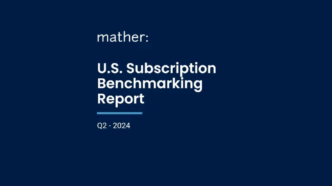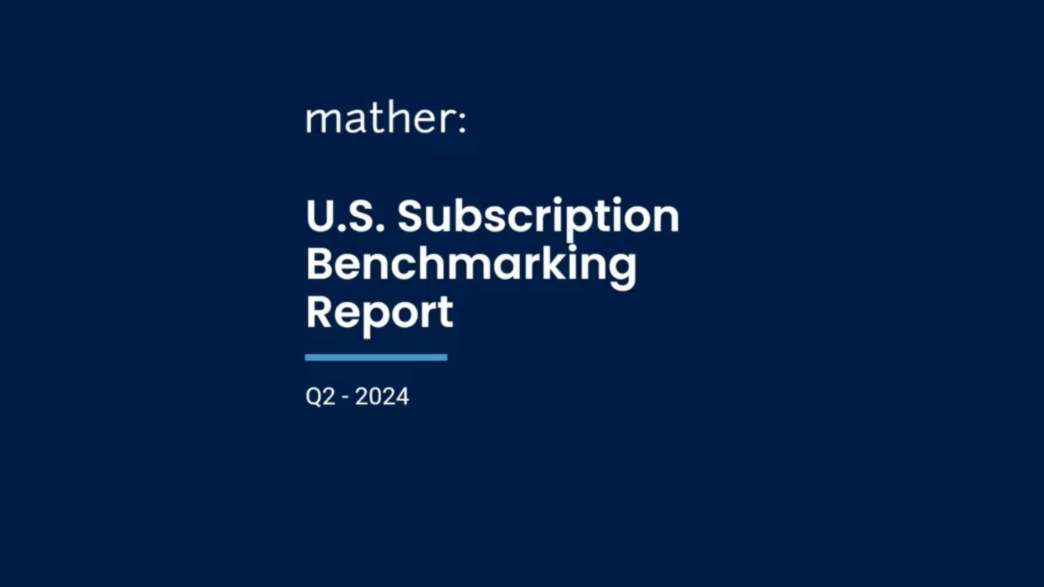

In today’s fast evolving media landscape, understanding subscription trends is more important than ever— especially as publishers navigate the complexities of optimizing their print and digital revenue streams. In this article, our partner Mather Economics presents key takeaways from their Q2 2024 Subscriber Benchmarking Report, which draws insights from over 200 newspapers across North America. With trends across 50+ acquisition, retention, and revenue metrics, their report offers actionable takeaways to help refine your strategies and drive sustainable growth.
Digital subscription volumes show signs of stabilization
Industry-wide efforts to improve conversion and retention are beginning to show progress, as evidenced by the slower decline in digital subscriptions in Q2 2024. While both print and digital subscriber volumes continued to fall, the median percentage change for digital subscribers improved from a 6% decline in Q1 to 5% in Q2. This is particularly noteworthy given the simultaneous drop in monthly users and digital acquisition rates, which have decreased in 2024 compared to 2023 for both hybrid print-digital and digital-only subscribers. Despite these challenges, the data suggests early signs of stabilization in digital subscription volumes.
> The conversion funnel framework to optimize subscriber conversion rates, explained
Q2 funnel performance indicates positive momentum
Although audience growth continues to be a challenge, publishers are making strides in nurturing readers, as demonstrated by a 65% increase in the median percentage of known users, which rose from 2.9% in Q1 to 4.8% in Q2. This growth is essential for gathering first-party data and effectively executing targeted email campaigns, newsletter strategies, and registration walls to boost digital engagement.
While understanding readers is crucial, presenting compelling offers at the right moments in their journey is equally important. Mather’s benchmarks show that the median paywall hit rate increased from 25% to 28%, and the conversion rate improved from 0.21% to 0.25% between Q1 and Q2, indicating greater conversion performance. AI-powered optimization solutions, such as Sophi’s Dynamic Paywall Engine, are essential for publishers looking to elevate their paywall strategies. By combining Mather’s data-driven strategies with Sophi’s advanced AI capabilities and Poool’s innovative paywall platform, publishers can enter a new phase of intelligent conversion that maximizes revenue potential and drives sustainable growth.
Retention trends highlight the digital maturity divide
Some publishers are seeing improved digital retention, although results vary significantly across different markets and maturity levels. Notably, mid-sized publishers are retaining more digital subscribers even as they face greater losses in print subscribers compared to their smaller counterparts. In Q2, digital churn rates for publishers with 10,000 to 100,000 active subscribers ranged from 3.37% to 3.45%, while the industry median churn rate stood at 4.1%.
Mather has long advocated for a proactive approach to retention, providing data-driven strategies and tactics that help publishers pinpoint the factors contributing to churn in their specific markets. By identifying at-risk subscribers, publishers can implement targeted actions to protect both revenue and subscriber volumes.
> NZZ: how do you inspire and retain in the first 100 days?
Digital evolution is ongoing: strategic pricing is essential
Although there is a notable decline in print volume and lower introductory prices, Mather projects that it will take more than two years for digital revenue to surpass print revenue. While the drop in digital volume is slowing, digital revenue continues to grow steadily. In Q2, digital introductory prices saw a slight increase, starting at $1.70 per month, while print introductory prices averaged around $13.66 per month.
To optimize introductory pricing, adopting a lifetime value-based approach is crucial. This strategy allows publishers to strike a balance between quality and quantity, ensuring subscriber retention while strategically increasing revenue.
Mather’s data indicates that price sensitivity for digital subscriptions is slightly lower, suggesting that we have not yet reached the ceiling for what digital subscribers are willing to pay. This creates opportunities for more aggressive pricing strategies to enhance average revenue per user (ARPU). However, any price increases must be implemented thoughtfully. Mather’s Market-Based Pricing solution equips publishers with the insights needed to optimize pricing decisions, maximizing revenue while minimizing churn.
Transforming insights into action
In summary, while print revenue continues to decline, the digital landscape is stabilizing, with slower declines in volume and stronger conversion and retention—clear indicators of growing digital maturity. To navigate this shift successfully, publishers must evaluate their digital readiness and determine the optimal print runway to sustain revenue. Pricing will be a pivotal lever in this transformation. Crafting the right revenue strategy is complex, but with Mather as your strategic partner, you can unlock meaningful growth and stay ahead of the curve.
By Isabelle Alzona, Senior Consultant at Mather Economics.











